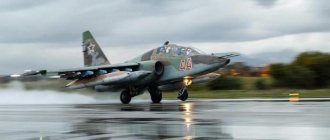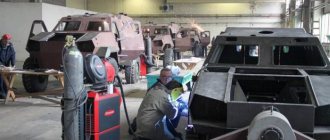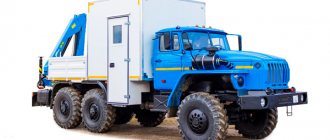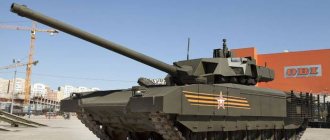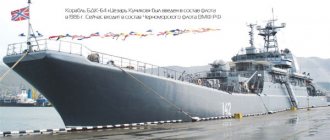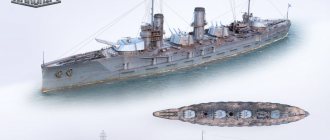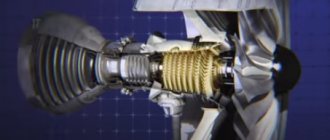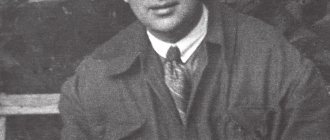MiG aircraft are being developed by the Mikoyan and Gurevich Experimental Design Bureau (MiG OKB), which was created in the late 30s of the 20th century, when the Soviet air force needed fighters with speeds of at least 600 km/h, with a high service ceiling and powerful weapons. This decision was dictated by an analysis of aviation combat operations in the skies of Spain and the Far East, as well as the result of familiarization of Soviet specialists with the German aviation industry.
MiG-1 aircraft
In December 1939, at the Moscow aircraft plant No. 1 named after. Aviakhim by order of director P.A. Voronin organized an independent special design department (OKO) for the design and construction of the I-200 high-speed fighter ("X", ed. 61). This aircraft was supposed to surpass in speed other domestic and foreign combat aircraft of those years. Artem Ivanovich Mikoyan was appointed head of OKO, and Mikhail Iosifovich Gurevich was appointed his deputy.
The Soviet Air Force needed to quickly update its aircraft fleet, and the I-200 was created in record time. By the day of the organization of OKO - December 8, 1939, the development of the preliminary design was completed. On December 25, the aircraft mock-up was reviewed and approved. At the beginning of February 1940, the production of working drawings was completed, and on March 31, the first prototype of the fighter left the assembly shop. After completion of ground testing, on April 5, test pilot A.N. Ekatov lifted him into the air.
The first MiG-1 smolet (photo)
At the beginning of factory tests, the I-200 fighter showed high flight characteristics. Therefore, by the decision of the Defense Committee under the Council of People's Commissars of the USSR on May 25, 1940, it was put into mass production at aircraft plant No. 1 named after. Aviakhim. In September, the second and third prototypes successfully passed state tests, at the end of October the first production I-200 aircraft, called “MiG-1”, began to leave the assembly shop of the plant, and in December their delivery to combat units of the Air Force began.
MiG-3 fighter
On October 21, 1940, an improved copy of the I-200 (MiG-3) fighter was transferred to factory testing, on which the fuel supply was increased and the identified deficiencies were eliminated. October 29, test pilot A.N. Ekatov performed the first flight on it. In parallel with the tests, the introduction of the new machine into series was in full swing, and already on December 20, the MiG-3 completely replaced the MiG-1 in mass production.
The MiG-3 became the fastest and highest altitude fighter of the Soviet Air Force in the pre-war period and at the beginning of the Great Patriotic War.
MiG-3 – photo
In 1941, up to 25 MiG-3s were produced per day. By the beginning of the Great Patriotic War, MiGs became the most popular type of new generation fighters in the Soviet Air Force: their share reached 89.9%. In October 1941, when the enemy was approaching Moscow, plant No. 1 and OKO were evacuated to Kuibyshev (Samara). Production of the MiG-3 continued here, but at the end of December 1941 it was discontinued. Having survived losses and evacuation, the engine-building industry could not provide a sufficient number of engines necessary for the MiG-3.
Total 1940–1942 100 MiG-1 and 3,172 MiG-3 aircraft were built. Read more about the technical characteristics of the MiG-3 in the article at the link.
MiG-3 fighters – video
MiG-9 fighter
In 1946, mass production of I-300 aircraft was launched at plant No. 1 named after. Stalin in Kuibyshev and adopted by the Air Force under the name MiG-9. In total, 604 MiG-9 fighters came out of the workshops of plant No. 1. Two training modifications were also built on the basis of the MiG-9 - I-301T (“FT-1” and “FT-2”). For the first time in domestic practice, an ejection seat was tested on the FT-2 aircraft. Read more about the technical characteristics of the MiG-9 in the article at the link.
MiG-9 fighter
MiG-8 aircraft (duck)
In February 1945, OKB-155 began work on the experimental MiG-8 aircraft. In the explanatory note to the preliminary design, designers A.I. Mikoyan and M.I. Gurevich justified the construction of this aircraft as follows: “The “duck” type aircraft was designed and built by us as an experimental one with the aim of testing the stability and controllability of machines of this design in the air and testing the operation of the wing with a large sweep...” The “duck” type aircraft has a horizontal tail in front, and the wing is at the back. Blowing the model in the T-102 TsAGI wind tunnel made it possible to obtain a maximum speed of 240 km/h. The MiG-8 aircraft was made according to the canard design and was a slanted high-wing aircraft with a fixed landing gear with a nose wheel. The aircraft of this design was not put into mass production. Read more about MiG-8 aircraft in the article at the link.
MiG-8 aircraft (duck) – photo
The first Soviet swept-wing fighter MiG-15
By a resolution of March 11, 1947, the Council of Ministers of the USSR approved a plan for the experimental construction of aircraft for 1947, according to which, by order of the MAP dated April 15, 1947, OKB-155 was to develop a front-line fighter with a jet engine and a pressurized cockpit. Management of the design and development work on the creation of the I-310 (“S”) aircraft with the RD-45F engine - the future MiG-15 - which began in January 1947, was entrusted to Deputy Chief Designer A.G. Brunov and engineer A.A. Andreeva.
The MiG-15 aircraft became the first Soviet production fighter with a swept (35°) wing. Subsequently, serial production of MiG-15 fighters and its modifications was carried out at 9 aircraft factories of the USSR, where a total of 13,131 aircraft of this type were built. In addition, serial production of the MiG-15 was established under Soviet license in Poland and Czechoslovakia. The total production of the MiG-15 reached a record value for jet fighters - more than 18 thousand aircraft.
The MiG-15 aircraft was distinguished by its simplicity and reliability of design, high flight and operational qualities, as well as powerful armament, consisting of one 37 mm caliber gun and two 23 mm caliber ones. In terms of basic flight characteristics, it even exceeded the tactical and technical requirements: at an altitude of 5000 m, the speed of the MiG-15 was 1028 km/h, and at an altitude of 2620 m – 1042 km/h. On the basis of the MiG-15, the UTI MiG-15 (“ST”) trainer fighter was built, which was also put into service and put into mass production. You can read more about the MiG-15 fighters in the article at the link.
MiG-15 – video
MiG-17 fighter
The success of the MiG-15 allowed OKB-155 to receive from the country's top leadership a kind of carte blanche for further improvement of this machine. In 1949, OKB-155 carried out work to modify the serial MiG-15 fighter for the VK-1 engine with a thrust of 2700 kgf, which made it possible to improve the flight characteristics of the aircraft. The maximum speed increased to 1076 km/h. Subsequently, the aircraft, which received the name MiG-15bis (“SD”), was also equipped with faster-firing NR-23 cannons, a hydraulic booster in the aileron control system, as well as OSP-48 blind approach equipment.
MiG-17 fighter in the photo
As a result of further improvement of the MiG-15bis, the I-330 (“SI”) fighter was created, which received the name MiG-17 when put into service. His wing sweep increased from 35° to 45°. The wing profile has become thinner. In addition, the fuselage of the aircraft was lengthened and the area of the brake flaps was increased. These measures made it possible to improve its speed and maneuverability: the maximum speed of the MiG-17 was already 1114 km/h. After successful completion of the tests, the aircraft was put into service and produced at five serial factories. The development of an engine with an afterburner VK-1F and its installation - for the first time in domestic practice - on the MiG-17F (SF) aircraft made it possible to further improve its flight characteristics. MiG-17F aircraft were mass-produced at factories in Komsomolsk-on-Amur and Novosibirsk.
A total of 8,045 MiG-17 aircraft of all modifications were produced at serial factories. Read more about the technical characteristics of the MiG-17 in the article at the link.
The MiG-17 became the first serial fighter in our country capable of reaching the speed of sound in a dive.
MiG-17 fighter – video
MiG-19 supersonic fighter
The first step towards the creation of the first Soviet serial supersonic fighter MiG-19 was the experimental I-340 (SM-1) aircraft with two AM-5 engines with a thrust of 2000 kgf, built in 1951 on the basis of the MiG-17. In the same year, another experimental supersonic fighter was created - the I-350 (“M”) with a TR-3 engine. Due to the lack of development of the engine, the latter did not receive development, and on the basis of the SM-1, an experienced escort fighter I-360 (SM-2) was developed with the same engines, but with a new aerodynamic configuration, which included a wing with a sweep of 55°.
photo of MiG-19 fighter
After rearranging the tail unit (to increase efficiency, the stabilizer was moved to the fuselage) and installing afterburning AM-9 (RD-9B) engines with a thrust of 3250 kgf, the aircraft received the name SM-9. Already in the first test flights, test pilot G.A. Sedov overcame the speed of sound on it, and then reached a maximum speed of 1400 km/h. At the beginning of 1954, the aircraft under the designation MiG-19 was put into serial production at the plant in Gorky, and soon in Novosibirsk. Since March 1955, the MiG-19 began to enter combat units of the Air Force. The MiG-19 became the world's first aircraft capable of reaching supersonic speed in horizontal flight when launched from the ground. Read more about the technical characteristics of the MiG-19 in the article at the link.
During serial production, 1,890 MiG-19 aircraft of all modifications came out of the factories. Licenses for the production of the fighter were transferred to Czechoslovakia and China.
MiG-19 fighter – video
dK PUYAHPEMKH ANEBSHU BNGLNFMNYAREI HYARPEAHREK lHts-29 OPH DEYARBHKH ON MUGELMSHL ZHEKL B 1984 Ts. llg HL. y.h.lKHYNMYU PYUGPYUANRYUK OPNEIR LNDKHTHYUZHHH, ONKSVKHBYEI MYUGBYUMKHE lHts-29 (KhGD. ╚9-14╩), nR OPEDSHDSYKHU BYUPKHYUMRNB YAYULNKER NRKHVYUKYA MNBNI YAKHYARELNI S OYUBKEMKH BNNPSFEMHEL, B YNRNPSC ASHKYU BYKCHVEMYU KYUGEPMN-REKEBHGKHNMMYU OPHZHEKEMYU YAKHYARELYU (cut) "p'AKHMYU" B ONDBEYAMNL YNMREIMEPE (RYUYSCH YOOOOYUPYURSPS OKYUMHPNBUKNYAE OPHLEMHRE KH MU LNDEPMKHGKHPNBUMMSHU HYARPEAHREKU-ANLAYUPKHPNBYKHYUU lHts-27l, Yu RUYFE MU OEPYAOEIRKHBMSHU KETSYKHU URSPPLNBHYUU ╚101╩ llg HL. YANYARYUB BNNPSFEMKH ╚9-14╩ ASHK DNONKMEM SOPYUBKELSHLH YAPEDYARBYULH ONPUFEMKH MUGELMSHU JACKEYS - PYYERYULH u-25lk, u-25lo, u-29k, u-29r X u-31o, YNPPEIRKHPSELSHLH ANLAYULH yua-500yP X yua-500k, YU LYYYAHLYUKEMYU ANLANBUYU MYUTSPSGYU YAYULNKERYU BNGPNYAKYU DN 4500 YTS (ASHKKH BBEDEMSH DBE DNONKMHREKEMSHE RNVYYKH ONDBEYAYKH BNNPSFEMKH OND YPSHKNL H NDMYU - OND TCHGEKFEL, VRN ONGBNKHKN ONDBEBHBYURE MU KHYARPEA HREKE DN DEBERKH ANLA tua-500).nAMYUPSFEMKHE X PUYAONGMYUBYUMKHE MUGELMSHU JACKEYS OKYUMHPNBYUKNYAE NYASYYARBKRE REKEBKHGHNMMSHL YUMYUKNL cut "pЪAKHMYU", KHGLEPEMKHE DUKEMNYARKH DN MKHU - BUNDY L B EE YNLOCAIR KYUGEPMSHL DUKEMNLEPNL. dK ZHEKESYUGYUMKH ONKSYUYRKHBMSHL TSNKNBYUL YAYULNMYUBEDEMKH PUYER u-25lk, u-29k X YNPPEIRKHPSELSHU ANLA yua-500k OPEDONKYUTSYUKNYAE HYAONKEGNBURE KYUGEPMSHY YUMYUK cro I “pAKHMYU”, YU OYUYAKHBMSHL tsam OPNRKHBNPUDHNKNYUZHHNMMSHU PYUYER u-25lo X u-31o — YOOOYUPYURSPS SOPYUBKEMKH “oPNTSPEYAYA-m”, PYUGLEYYUELSCH B ONDTCHGEKFMNL YNMREEMEPE BLEYARN cut “pЪAKHMYU╩”.
oPNRNRHONL lHts-29 RHOYU ╚9-14╩ DNAFEM ASHK YARYURE OEPENANPSDNBYUMMSHI B YNMZHE 1984 Ts. YAEPHIMSHI lHts-29 ╧0707, ONKSVHBKHI ╧407. dNPYUANRYUMMSHI YAYULNKER BSHYURKHKH MU YUSCHPNDPNL 27 DAYUAP 1984 Ts., X 13 TEBPYUK 1985 Ts. KERVKHY-HYAOSHRYUREKE r.n.yUSAYUYKHPNB ONDMYK ETSN B OEPBSHI ONKER. ONYAINKEYS MNBU YAKHYARELYU SOPYUBKEMKH BNNPSFEMHEL EYE ME ASHKYU TSNRNBYU, LYUHMS PE'EMN ASHKN HYAONKEGNBURE B YANNRBERYARBKHH I OPNTsPYULLNI HYAOSHRYUMKHI HYARPEAHREK LHTS-2 9 RHOYU ╚9-13╩. nyanane BMHLUMKHE SDEKKNYAE NOPEDEKEMHCH YUYUYYUREPHYARKHY ONOEPEVMNI SOPYUBKELNYARH YYULNKERYU I SBEKKHVEMMSHL TsPNRNL X AKNYULH OYYAYAHBMSHU ONLEU OEPED TNPYHKILH OPH ONKERE MU ANKEHU STSKYU YURYUYKH. ON PEGSKERYURYUL SCHRKHU HYAOSHRYUMKHI ASKYU DNPYUANRYUMYU YAHYARELYU YUBRNLYURKHVEYAYNTSN SOPYUBKEMKH: SLEMEYEM SCNK NRYKNMEMKH SCKEPNMNB OPH STSKYU YURYUYKH ANKEE 18╟ X SBEKKHV EM DN ╠8╟ SCNK NRYKNMEMKH PSKEI MYUOPYUBKEMKH NR YUBRNMNLMSHU PSKEBSHU LYUKHMNY (UPL). KERNL 1985 Ts. YU YAOSYAR LEYAZH, 9 YUBTSSYARYU, — LYuYaYANTSYuAYuPHRMSHI LUYER YNMREIMEPYU cut ╚pЪAKHMYU ╩. ndMUYN DN HYAOSHRYUMKHI MU ANEBNE OPHLEMEMHE DECN ME DNKN. ONYAYNKASE I YAEPEDHMSH 80-U CC. nya SFE KHMREMYAKHBMN PUANRYUKN MYUD YANGDYUMHEL LNDEPMKHGHPNBUMMNTSN HYARPEAHREK lHts-29l, B YANYARYUB BNNPSFEMKH YNRNPNTSN RUYFE BYKCHVYUKHYAE YAPEDYARBU BSHYANYNRNV MNCN ONPYUFEMHJ MUGELMSHU JACKEY, PEEMN ASHKN NRYUGYUREYAYA NR OPNDNKFEMKH OPNTsPYULLSH ╚9-14╩, YU EDKHMYARBEMMSHHI ONYARPNEMMSHHI OPNRNRKHO HYAONKEGNBYURE DK DUKE MEIHU HYAOSHRYUMKHI B KHMREPEYUU SKSVIEMHYUYUPYUREPHYARKHY YAEPHIMSHU HYARPEAHREKEY .
b 1986 C. lHts-29 ╧407, OPHBEDEMMSHY YARYUMDYUPRS RHOYU ╚9-13╩, SVYUYARBNBUK B HYAOSHRYUMKHU ON NZHEMYE BKHЪMHЪ DHTTEPEMZHYUKEMNTSN NRYKNMEMKH YNM YANKEY YARYUAHKHKHYURNPYU X YAEIZHHI ONBNPNRMSHU MNYAYNB YPSHKYU (BMSRPEMMHE YAYEZHHH BSHOSYAYUKKHYAE MU SCNK -30╟, BMEMKHE - MU SCNK - 10╟) MU YUYUPYUREPHYARKHYKH ANINBNTSN DBHFEMKH YAYULNKERYU OPH ONKERE MU STSKYU YURYUYKH ANKEE 25╟. xGSVYUKYUYAE BNGLNFMNYARE SBEKKHVEMHЪ STSKNB ╚YUMRKHGYUBHYAYUMH╩ SCHKEPNMNB DN -10╟ X -15╟, Yu RUYFE STSKNB NRYKNMEMKH PSKEI MYUOPYUBKEMKH NR yupl DN ╠15╟. ON PEGSKERYURUL SHCHRHU HYAYAKEDNBYUMKHI B yayus ASHKKH BMEYAYEMSH MENAUNDHLSHE HGLEMEMKH, VRN ONGBNKKHKN DNAKHREYA PUYAKHPEMKH DHYUOYUGNMY DNOSYARKHLSHU STSKNB YURYUKH, OPH YNR NPSHU YANUPYUMYERYA SDNBKERBNPHREKEMYU ANINBU SYARNIVKHBNYARE H ONOEPEVMYU SOPYUBKELNYARE YYULNKERYU. ONSCHRNLS YAYULNKER ╧407 LNFMN YAVKHRYURE NDMHL HG OPNRNRKHONB LNDEPMKHGHPNBUMMNTSN KHYARPEAHREK lHts-29ya (N MEL PEVE ONIDER DUKEE), LYUYAHLYUKEMN DNOSYARKHLSHI SCSC Y RUYH YNRNPNTSN DNYARHTS 28╟.
b DEYUAPE 1989 C. MU lHts-29 ╧407 ASHKN BSHONKMEMN MEYAINKEIN HYAOSHRYUREKEMSHU ONKERNB MU LRNONP.
th MYUVYUKS 1991 Ts., YNTsDU 407-I BOEPBSHE PEHKKH ONYUGYURE MU LEFDSMYUPNDMNI BSHYARYUBYE, MU MEL YANBEPHKH SFE ANKEE 500 ONKERNB. gYUPSAEFMYU OPELEEPYU YAYULNKERYU YANYARNKYUYAE MU YUBKHYUYUKNME MU tKKHOOHMYUU. OEPEKER B LYUMHKS ASHK BSHONKMEM 4 LYUPRY 1991 Ts. bePMSBHYAE B pNYYAKHCH, KHYARPEAHREKE NORE MYUVYUK KERYURE ON OPNTsPYULLYUL NZHEMYKH SARNIVKHBNYARKH SOPYUBKELNYARKH OPH PUGK KHVMSHU BYUPHYUMRYU MYYARPNNIYH yayus. b YAEMRIAPE 1992 C. ╚AEG NRPSHBYU NR OPNKHGBNDYARBYU╩ lHts-29 ╧407 BMNBE YARYUK SVYUYARMKHYNL GYUPSAEFMNI BSHYARYUBYKH - MU SCHRNR PYUG B TYUPMANPN. xMREMYAHBMSHE ONKERSH MU LYUHME OPNDNKFYUKHYAE DN KERYU 1993 Ts. (Y 12 KHCHKЪ 1993 Ts. MU MEI YANBEPHKH 698 ONKERNB), NDMUYN H OH YAEI DEME NMYU NRYUERYA B KERMNL YANYARN MXX. b YNMZHE 1997 Ts. MU lHts-29 ╧407 ASHK BSHONKMEM OEPBSHI BGKER I LNAKHKEMNTSN YUSCHPNDPNLMNTSN RPYULOKHMYU (YAL. TSKYUBS “b YARPNCH”). b MYUVYUKE 1998 Ts. YAYULNKER NYAMYARHKH SYAKHKEMMSHL YUYAYAH I YNKEYAYULH yr-209, NAEYAOEVKHBUCHYHLH ONYYUDYS I SBEKHVEMMNI DN 16200 YTS LYuYAYANI (B KHMREPEYUU YANGDYUMKH L NDEPMKHGKHPNBUMMNTSN KHYARPEAHREK lHts-29Yalr). cru:
| lNDHTHYUZHH | lHts-29 |
| pYUGLUU YPSHKYU, L | 11.36 |
| dKKHMYU YYULNKERYU YAN RYUMTSNI obd, L | 17.32 |
| bSHYANRYU YAYULNKERYU, L | 4.73 |
| OKNYYUDE YPSHKYU, L2 | 38.06 |
| I love it, JC | |
| OSYARNTSN YYULNKERYU | 11400 |
| MNPLYUKEMYU BGKERMYU | 15800 |
| LYUYAHLYUKEMYU BGKERMYU | 18600 |
| рНОХБН, K | |
| BMSRPEMEEE | 4540 |
| ora | 3800 |
| RHO DBKHTSUREK | 2 rpddt PD-33 |
| rtsyu, ytsya: | |
| TNPYAKHPNBYUMMYU | 2 U 8300 |
| LYUYAHLYUKEMYU | 2 U 5040 |
| LYUYAHLYUKEMYYAINPNYARE, YL/V. | |
| MU BSHIANRE | 2450 (l=2.3) |
| WITH GELKH | 1500 |
| oPUYRHVEYAYU DUKEMNYARE, YL. | |
| MU LUKNI BSHYANRE | 710 |
| MU ANKENI BSHYANRE | 1500 |
| I'm an ora | 2160 |
| LYUYAKHLYUKEMYYAINNONDZELMNYARE, L/LHM | 19200 |
| oPUYIRKHVEYAYKHI ONRNNKNY, L | 18000 |
| lyuYa. SHYYAOXYURYUZHNMMMYU OEPETSPSGYU | 9 |
| ShYKHOYUF, VEK | 1 |
| bNNPSPHEMHE: | NDMNYARBNKEMYU 30-LL OSYU ts-301 ANEBYU MYUTSPSGYU - 4500 YTS MU LEYARKH ONDIPSHKEEBSHU SGKYU DBE PUYERSH YAPEDMEI DUKEMNYARH p-27p X DN 6 PUYER AKKHFMETSN BNGD SMNTSN ANJ p-73 HKH p-60l ANLASH 250- HKH 500-YTS, YNMREIMEP yltss mup 80 i-8 B AKNYUU a-8l1 X i-24a |
| bottom. KhMTNPLYUZHKH: |
| tNRNCPYUTHH: | LHts-29 (“9-14”) |
| LHts-29 (“9-14”) | |
| LHts-29 (“9-14”) | |
| LHts-29 (“9-14”) | |
| LHts-29 (“9-14”) | |
| LHts-29 (“9-14”) | |
| LHts-29 (“9-14”) |
IWELSH:
| LHts-29 (“9-14”) |
| YaOHYANY HYARNVMKHYNB: |
| oNKHTSNM. e.tsNPDNM, y.tNLHM, y.lHUEEB. lHts-29 yPSHKE PNAYAHH. KHYARNPKH YAYULNKERSH Nya "lHts" yBKHYUZHKH bPEL. bYUKEPHI lHTSSMNB. BEKHYNKEOMYU "DEBRYU" yPSHKE PNDHMSH. lHUYUHK kEBHM. рНР YAYULSHI "lHts" yuBKHYUZHKH bPEL. bYUKEPHI lHTSSMNB. hYARPEAHREKE lHts-29. schOKHGNDSH HYAOSHRYUMHI bKYUDHLHP hKEHM. LHts-29, "LHPYuF" 2000, F-16. gBEGDSH VERBEPRNTSN ONYNKEMKH pNLUM yuYARYUNB. PSYAYAYU YAHKYU. tPNMRNBNI HYARPEAHREKE lHts-29 4+ Publishing. Piotr Butowski. MiG-29 all variants Janes's. Jon Lake. Mikoyan MiG-29 Fulcrum Lock On. Zoltan Buza. Mikoyan MiG-29A/C Fulcrum |
sTSNKNY MEAYU. 2006



